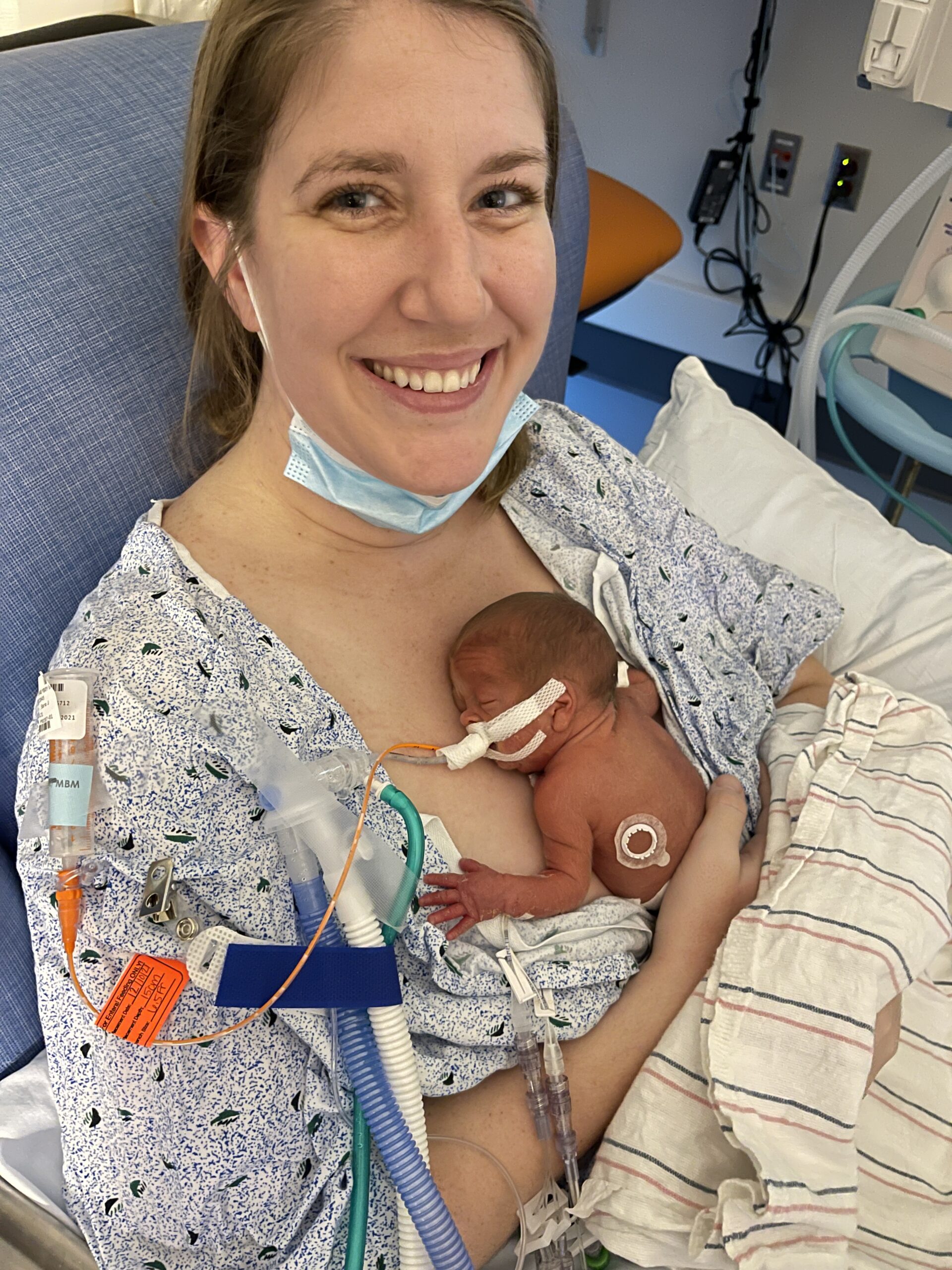By Chelsea Lee, BSN, RNC-NIC
Every aspect of neonatal care matters, from the sounds infants hear to their exposure to light. Because of this, NICUs have increasingly focused on creating and nurturing developmentally supportive environments, particularly for premature infants, which allows healthcare providers to optimize the infant’s development and promote their long-term health. Part of creating this supportive environment can include creating a quiet and dimly lit space to reduce sensory overload, using music therapy to reduce stress and pain, and the implementation of a care strategy known as kangaroo care.
Kangaroo care, also known as kangaroo mother care or skin-to-skin contact, is a method of holding a newborn baby on the bare chest of the mother or father, with their skin in direct contact. This method of care is especially important for premature and low birth weight infants, and has been shown to be beneficial for all babies, as well as parents, making it a strategy that has been widely adopted in delivery rooms and NICUs alike.
What’s the history of kangaroo care?
The term “kangaroo care” was first used in the late 1970s in Bogota, Colombia by physician researchers Edgar Rey Sanabria and Héctor Martínez-Gómez. Borne out of the difficulties they experienced caring for premature newborns, they introduced the Kangaroo Mother Program, which centered around the method of skin-to-skin contact. It was found that placing premature babies in skin-to-skin contact with their mothers helped promote better health outcomes, a significant finding at a time when the infant mortality rate in Columbia was just shy of 50%.
Since then, kangaroo care has been adopted as a common practice in NICUs around the world, as it has been shown to have many benefits for both premature and full-term babies.
The benefits of kangaroo care in the NICU
Participating in kangaroo care in the NICU has been found to offer numerous advantages for infants, particularly for those born prematurely, as well as their parents. The benefits of kangaroo care include:
Improving breastfeeding & infant weight gain
Research has demonstrated that kangaroo care can have a positive impact on breastfeeding outcomes for premature babies. A study published in the Journal of Pediatric Nursing found that infants who received kangaroo care had longer breastfeeding sessions and consumed more breast milk compared to those receiving conventional care. This is especially significant for premature and low birth weight infants who typically struggle with gaining weight; evidence shows that kangaroo care can help accelerate their weight gain.
Regulating the baby’s body temperature
Research suggests that holding babies in skin-to-skin contact can help them to regulate their body temperature more effectively. A study published in the Journal of Neonatal Nursing in 2023 investigated the effect of kangaroo care on neonatal body temperature, comparing those who received this care with those who did not. The study revealed that neonates who engaged in skin-to-skin contact during kangaroo care had higher temperatures measured both during and after the care session. These findings are important for premature babies in the NICU, who are particularly at risk for hypothermia due to their lack of thermoregulation.
Promoting bonding
Kangaroo care has the potential to foster a deep sense of connection between parents and their newborns. This form of care enables parents to hold their babies close, facilitating an emotional bond that can be essential for the wellbeing of both the infant and the parent. According to a study involving 100 mothers of premature babies, kangaroo mother care resulted in significantly higher levels of maternal attachment. This connection can be impactful during the NICU stay, where opportunities for parent-infant interaction is often limited.
Reducing stress
Kangaroo care has been shown to reduce stress in premature babies and their parents. Skin-to-skin contact releases the hormone oxytocin, which works to block the body’s stress response. One particular study demonstrated that kangaroo care for over 90 minutes per day in the first two weeks of an infant’s life led to a significant reduction in preterm and maternal cortisol levels, as well as a reduction in maternal postpartum depression. Decreasing stress in the NICU setting is paramount for several reasons, including the adverse effects that elevated stress levels have been shown to have on the body.
Reducing pain response
There is evidence to support that kangaroo care can significantly reduce an infant’s response to pain. This is especially crucial in the NICU, where infants undergo numerous painful procedures, such as blood draws, on a daily basis. That, added to the fact that preterm infants are not yet able to adapt to repeated exposures to pain, makes finding ways to reduce pain in the NICU an important aspect of care. These early experiences of pain have also been linked to long-term negative consequences for neonates, such as lower mental developmental scores at 18 months. To help mitigate the adverse effects of pain in NICU infants, kangaroo care can be implemented as a critical addition to their care strategy.
How to do skin-to-skin contact with a newborn
The process of engaging in skin-to-skin contact may vary from facility to facility, but NICUs practicing this care strategy often employ some or all of the following steps:
- The parent will choose a comfortable chair or bed to sit in.
- The baby’s clothes will be removed, leaving only a diaper on.
- The parent will create a space on their chest to place the baby, removing any clothing that would create a barrier.
- The baby will be placed upright on the chest, facing the parent.
- The baby’s back may be covered with a blanket or cloth to keep them warm and comfortable.
- It may be advised that the baby stay in this position for at least an hour, allowing the parent to take time to relax and bond with their baby.
- Kangaroo care is encouraged to be repeated multiple times per day, as many days a week as the infant can tolerate.
Kangaroo care in the NICU is an impactful addition to an infant’s care, offering a range of benefits for both babies and their parents. It is more than just a physical act; kangaroo care represents a significant emotional experience that can strengthen the bond between parents and their baby. The NICU can be an overwhelming environment, with an abundance of machines, monitors, and uncertainty. Kangaroo care provides a moment of connection and empowerment, reminding parents that they are not alone and emphasizing the essential role they play in their child’s care.
Kangaroo care: a real NICU story
Emily’s baby boy, Owen, was born premature, weighing just 1.98 pounds. Owen was admitted to the Penn State Children’s Hospital NICU, where he received around the clock care. Emily and her husband used kangaroo care to comfort and bond with Owen throughout their NICU stay, and recognizes the regular skin-to-skin contact as a crucial aspect of their journey in the NICU:
“Kangaroo care was my saving grace in the NICU. After waiting 12 days to hold Owen, I did kangaroo care for close to 3 hours each day! I truly believe we wouldn’t be where we are today without all of the skin-to-skin my husband and I were able to do with Owen.”
A Clinician’s Perspective
Clinicians who witness the implementation of kangaroo care in their own unit commend the approach and acknowledge the clear benefits it provides for both NICU patients and their parents. Jennifer Erkinger of the Penn State Children’s Hospital NICU, the same unit where Owen’s journey took place, explains the incredible impact of kangaroo care that she has experienced firsthand:
“During kangaroo care in the NICU, we see babies get right on Mom’s chest, and all of their vitals start to even out–it’s beautiful. Kangaroo care is imperative to allow that bonding experience to happen, because these parents feel helpless, in every sense of the word. It’s so important because when they create that bond, mom and dad keep coming, and they don’t abandon their child. And I truly believe that the best preemies are the ones that have that constant parent interaction.”
Jennifer Erkinger, MS, RRT-NPS, AE-C, C-NPT
Pediatric Clinical Specialist Respiratory Therapy
Neonatal ECMO Coordinator
Penn State Children’s Hospital

Emily and Owen in Penn State Children’s Hospital NICU
How The Penn State Level 4 NICU Implemented Transcutaneous Monitoring
References:
- Kostandy, R.R., Ludington-Hoe, S.M. The evolution of the science of kangaroo (mother) care (skin-to-skin contact). Birth Defects Res. 2019.
- The World Bank. Mortality rate, infant (per 1,000 live births) – Colombia. Accessed May 9, 2023. https://data.worldbank.org/indicator/SP.DYN.IMRT.IN?locations=CO.
- Kucukoglu, S., et al. The Effect of Kangaroo Care on Breastfeeding and Development in Preterm Neonates. J Pediatr Nurs. 2021.
- Evereklian, M., Posmontier, B. The Impact of Kangaroo Care on Premature Infant Weight Gain. J Pediatr Nurs. 2017.
- Eksirinimit, T., et al. Effects of Kangaroo Care on body temperature of premature infants and maternal satisfaction at Maharaj Nakhon Si Thammarat hospital, Thailand. J Neon Nurs. 2023.
- Pereira C.B., et al. Thermoregulation in premature infants: A mathematical model. J Therm Biol. 2016.
- Mehrpisheh, S., et al. The Effectiveness of Kangaroo Mother Care (KMC) on attachment of mothers with premature infants. Eur J Obstet Gynecol Reprod Biol X. 2022.
- Cañadas, D.C., et al. Benefits of Kangaroo Mother Care on the Physiological Stress Parameters of Preterm Infants and Mothers in Neonatal Intensive Care. Int J Environ Res Public Health. 2022.
- Badr H.A., Zauszniewski J.A. Kangaroo care and postpartum depression: The role of oxytocin. Int J Nurs Sci. 2017;4(2):179-183. 2017.
- Yaribeygi, H., et al. The impact of stress on body function: A review. EXCLI J. 2017.
- Campbell-Yeo M.L., et al. Understanding kangaroo care and its benefits to preterm infants. Pediatric Health Med Ther. 2015.
- Rupawala M., et al. A developmental shift in habituation to pain in human neonates. Curr Biol. 2023.
- Grunau R.E., et al. Neonatal pain, parenting stress and interaction, in relation to cognitive and motor development at 8 and 18 months in preterm infants. Pain. 2009.





